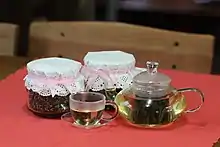 | |
| Type | Herbal tea |
|---|---|
| Country of origin | Korea |
| Ingredients | Korean mugwort |
| Korean name | |
| Hangul | 쑥차 |
|---|---|
| Hanja | -茶 |
| Revised Romanization | ssukcha |
| McCune–Reischauer | ssukch'a |
| IPA | [s͈uk̚.tɕʰa] |
Ssukcha (쑥차), also called mugwort tea or wormwood tea, is a traditional Korean tea made from Korean mugwort (called ssuk (쑥) in Korean).[1][2] It is commonly consumed in both North and South Korea.[3]
Preparation

The preparation involves leaves of mugwort harvested around the dano month (day 5 of the 5th lunar. This usually takes place around May and June in the Gregorian calendar). The leaves are washed, drained, chopped, and dried in a shaded area for 3‒10 days.[1][4] Dried mugwort leaves are then roasted in a round-bottomed deokkeum-sot (cauldron for roasting tea).[5][6] In a teapot, a handful of mugwort and a cup of water is added, and boiled for 5‒10 minutes.[4]
Medicinal use
Korean mugwort is rich in vitamin A, vitamin C, and minerals.[4] In the past, mugwort tea was believed to help prevent and treat the common cold, reducing fever and inflammation, relieving pain, and lowering blood pressure.[4]
Other uses
References
- 1 2 "ssukcha" 쑥차. Standard Korean Language Dictionary (in Korean). National Institute of Korean Language. Retrieved 23 March 2017.
- ↑ "ssuk" 쑥. Standard Korean Language Dictionary (in Korean). National Institute of Korean Language. Retrieved 23 March 2017.
- ↑ 오, 애리 (16 February 2017). "김정일 생일 75주년…쑥차로 추위 달래는 시민들". Newsis (in Korean). ISSN 1739-7529. Retrieved 23 March 2017.
- 1 2 3 4 "ssukcha" 쑥차. Doopedia (in Korean). Doosan Corporation. Retrieved 23 March 2017.
- ↑ 김, 지원; 박, 현영 (1 May 2016). "현숙씨의 사콤달근 밥차 '쑥차'". Gyeongnam Ilbo (in Korean). Retrieved 23 March 2017.
- ↑ 최, 오균 (8 April 2013). "아홉 번 덖어낸 임진강 쑥차, 맛보실래요?". OhmyNews (in Korean). Retrieved 23 March 2017.
- ↑ Foster, Steven (1994). Herbal Renaissance, Growing, Using & Understanding Herbs in the Modern World (Rev Sub ed.). Salt Lake City, UT: Gibbs Smith. p. 201. ISBN 9780879055233.